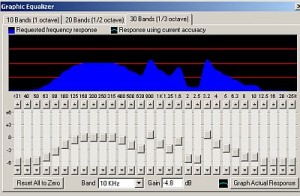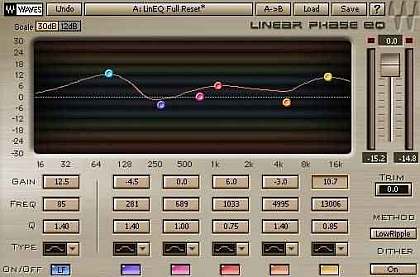Always use a highly accurate Parametric EQ
Parametric EQ are important surgical tools in audio mixing that you can use to shape the sound. You should be using them. For most beginners that are just new in audio mixing; they mostly do not know these tools.
Instead what they know is a graphic EQ since these are the EQ they used to see almost every day in their mp3 players, etc. For example this is a graphic EQ:

Unfortunately, graphic EQ does not allow you to set how narrow or wide are the EQ settings. For more accuracy, you should be using a parametric EQ which is suitable for this job. Take a look at this parametric EQ and notice that it has one additional parameter setting which is Q:

Do not use a cheap and low quality EQ because they have poor accuracy. Instead invest in quality digital audio mixing plug-ins like Waves.
Cut more, Boost Less
Boosting adds more issues than cutting in mixing. It is why it is recommended that in all EQ problems you would be focusing more on cutting than boosting.
Let me illustrate an example: Supposing you are mixing a track with weak vocal mid-range sound. You listen and find out that the guitar mid-range strumming frequencies are conflicting with the vocal sound. You have two choices here to solve this EQ issue but only one is recommended, see below.
NOT RECOMMENDED = Boost vocal mid-range frequencies until it dominates the guitar sound thus making it sound clear in the mix.
RECOMMENDED = Cut guitar mid-range until the vocal sits properly in the mix.
See the difference? The second option is more recommended and this is how the pros in mixing would solve this issue. Instead of boosting vocal EQ, you would simply be cutting the offending frequency which is the guitar mid-range. These results in clarity without un-naturally increasing the overall volume of the mix which can either leads to undesirable:
a.) Distortion or clipping
b.) Less headroom, since boosting EQ pushes levels further up.
Boost wide and Cut Narrow
Boosting is more desirable with very wide Q done at low gain. For example if you want a more vocal presence; it would be much beneficial to boost with:
+2dB Q=0.7 at 1000Hz
Take note that this is a wide boost since Q=0.7. This would have a profound effect on the vocal presence in the mix. In my experience, Q below 1.4 is considered to be very wide. For cutting frequencies, my minimum preferred Q would be 1.4 (usually above such as 2.0), cutting EQ less than 1.4 is considered very wide and is not advisable since it significantly alters the sound of instrument other than making it clear in the mix. For boosting, I would prefer values around 1.4 to 1.0 or even 0.7~0.8 for very wide boost with subtle boosting gain.
On the other hand, cutting is more desirable when done at narrow Q at higher reduction gain. This is necessary for precise and accurate EQ in solving tonal issues. A classic example is removing the boxy sound of the kick drum. Sometimes by sweeping through parametric EQ you should find this somewhere 300Hz to 400Hz (a very narrow range). And to remove this boxy sound, you would be applying like:
400Hz Q=5.0 -9dB
Now that’s a high cut done at a narrow bandwidth.
Watch out for clipping in your EQ output meters

Often beginners do not know that the output of EQ can be clipped particularly if you are boosting something. This is often one of the reasons why you should not be always boosting when doing EQ because of the high possibility that the output of the EQ is clipped.
Clipping in digital is unacceptable and can seriously degrade the quality of your mix. If you have a parametric EQ with output level meters, then use it and watch out for red (clipping). If it occurs; take action immediately by doing one of the following:
a.) Lower the input level.
b.) Lower the boost amount.
Content last updated on June 19, 2012









2 Responses
Hi Henry,
Thanks for the feedback. Although I cannot named something that is a poor quality DAW but I can describe it:
A. Quality of Digital summing and computational accuracy
In digital audio mixing, signals are summed in binary math (in 0’s and 1’s). Modern DAW uses higher resolution to reduce these computational errors (since digital is prone to errors because it is not an analog summing which purely sums up the voltages instead of numbers).
Back in the very early days of recording software, they are designed based in the hardware capability at that time. So mostly they only process 32-bit float data internally during digital mixing and plug-in calculations.
But it has been shown that 32-bit float data is more susceptible to experiencing digital errors because the results are rounded up in nature (in some extreme cases of calculation they cannot represent all numbers as the result of the calculation). Because of this, a 32-bit float data would round up to the nearest number. This rounding off can cause errors and will have an effect on sound quality. This is particularly frequent if you do drastic changes in your DAW such as a big EQ change, heavy compression settings, boosting or cutting large amount of dB.
Now, DAW seems to adopt a higher bit float standard which is 64-bit float. As you have expected this 64-bit float number representation can represented a WIDER scope of numbers in the DAW and plug-in calculation. 64-bit float though consumes a lot of CPU and memory usage compared to 32-bit float DAW however, with today’s modern computer hardware (faster and more efficient); this can be easily handled as compared before.
This would result to lesser computational errors in your DAW.
B. Lack of important features
Of course, no one would like to use a DAW that would lack a lot of important features. This is particularly true for older DAWs (and older versions too).
C.) Lack of support for modern plugins
Modern plugins (EQ, compressor, etc) are rewritten by developers to get an improvement in audio mixing quality. However this might appear incompatible to old DAW.
So if you are looking for a DAW, make sure it is modern and has the features as described previously. That would give you a nice audio mixing experience as well as getting that great sound from your mix.
For more details, you can read this post on the advantages of 64-bit DAW over 32-bit float Digital audio workstation.
Hey Emerson,
Fantastic site. Quick question. Here’s the quote.
“Also this will tend to worsen if you are using a combination of bad EQ plug-in, poor quality DAW (digital audio workstation) and bad recorded sound.”
Now…what deems a poor quality DAW?
Thanks again for all the great info.